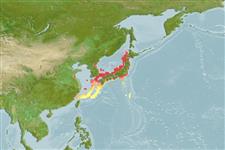Common names from other countries
Environment: milieu / climate zone / depth range / distribution range
Ecology
Marine; demersal; oceanodromous (Ref. 51243); depth range 139 - 155 m (Ref. 27311). Temperate; 50°N - 26°N, 120°E - 152°E
Northwest Pacific: Japan, the southern Korean Peninsula to the Yellow Sea (Ref. 5590; including the coast of Primorye (Ref. 114081).
Length at first maturity / Size / Weight / Age
Maturity: Lm 19.1 range ? - ? cm
Max length : 57.0 cm TL male/unsexed; (Ref. 40637); max. published weight: 2.4 kg (Ref. 40637)
Occurs in rocky coastal areas; often gather around artificial reefs. Breeds from October to December. The egg masses are attached to small rocks, guarded by the male (Ref. 559 and 637). Commercially cultured in Japan.
Male guards eggs.
Masuda, H., K. Amaoka, C. Araga, T. Uyeno and T. Yoshino, 1984. The fishes of the Japanese Archipelago. Vol. 1. Tokai University Press, Tokyo, Japan. 437 p. (text). (Ref. 559)
IUCN Red List Status (Ref. 130435)
CITES (Ref. 128078)
Not Evaluated
Threat to humans
Harmless
Human uses
Fisheries: commercial; gamefish: yes
Tools
Special reports
Download XML
Internet sources
Estimates based on models
Preferred temperature (Ref.
115969): 2.1 - 14, mean 5.7 (based on 7 cells).
Phylogenetic diversity index (Ref.
82804): PD
50 = 0.5159 [Uniqueness, from 0.5 = low to 2.0 = high].
Bayesian length-weight: a=0.00479 (0.00200 - 0.01144), b=3.12 (2.91 - 3.33), in cm Total Length, based on LWR estimates for this (Sub)family-body shape (Ref.
93245).
Trophic level (Ref.
69278): 3.8 ±0.3 se; based on diet studies.
Resilience (Ref.
120179): Medium, minimum population doubling time 1.4 - 4.4 years (Preliminary K or Fecundity.).
Fishing Vulnerability (Ref.
59153): Low to moderate vulnerability (34 of 100).
